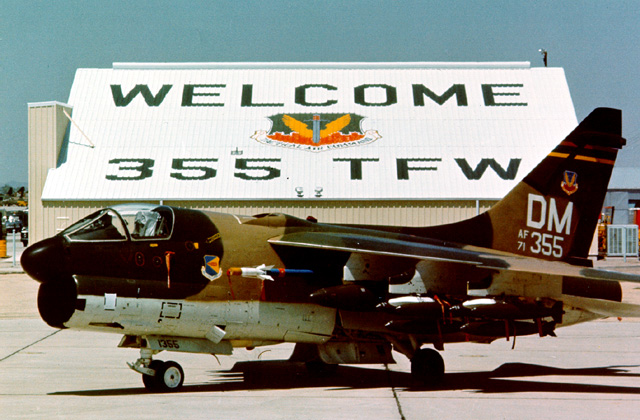





On July 1, 1971 the 355th Tactical Fighter Wing was reactivated at Davis-Monthan AFB, AZ. On July 16th, Col. John F. Barnes (Commander) and Col. Waymond C. Nutt (Deputy Commander of Operations) flew the wings' first A-7D's to Davis-Monthan AFB.
On November 15, 1972 the wing deployed 4 A-7D aircraft and 41 personnel to Howard AFB in the Panama Canal Zone to provide close air support for US Army training execises. The deployment was called Coronet Cove. These aircraft returned to Davis-Monthan AFB on February 1, 1974.
That deployment was followed by a six month TDY to Korat RTAFB in Thailand. A contingent of aircrews, mostly from the 354th TFS, flew air strikes into Cambodia. Known as Constant Guard VI, all personnel returned to Davis-Monthan AFB on July 12, 1973. A similiar deployment was made on December 21, 1973. The 355th deployed 23 pilots from the 358th TFS and 342 enlisted personnel to Korat RTAFB in Thailand to support the 354th Tactical Fighter Wing. All personnel supporting this deployment returned to Davis-Monthan AFB between May 16th-20th 1974.
On September 1, 1979 the 355th Tactical Fighter Wing was redesignated the 355th Tactical Training Wing. Just one month later on October 2, 1979 the 357th TFTS flew the last A-7D flight at Davis-Monthan AFB thus ending the 8 years of A-7D operations.
If you have any historical information, photo's, or personal stories that are related to the A-7's of the 355th TFW that you would like to share with me, please e-mail me at [email protected] Please remove the word "NOSPAM" from the e-mail address before sending e-mail.
The A-7 Corsair II was the result of the VAL (V=heavier than air, A=attack, L=light) study. Four designs were considered; one from Douglas Aircraft based on the A-4 Skyhawk, one from North American based on the FJ-1 Fury, one form Grumman based on the A-6 Intruder, and one from Vought based on the F-8U Crusader. In a time when everyone proclaimed the "Need for Speed", the Navy insisted that subsonic was actually the desired direction to go in order to achieve bombing accuracy. The Navy argued that even the faster fighter-bombers had to slow to subsonic speeds to deliver their ordinance and that most air to ground oridnance could not be delivered at supersonic speed anyway.
On February 11, 1964 Vought was declared the winner of the VAL competition. On September 27, 1965 the first A-7A made its first flight with the first operational A-7A delivered to VA-147 on October 14, 1966. By September 1967, the VA-147 had transitioned to the A-7A and within 3 months was flying the Corsair into combat. The A-7A's of the VA-147 squadron flew 1400 sorties with the lost of only one aircraft.
The Air Force was quick to notice the A-7 and started developing its own version, the A-7D. One of the main improvements made by the Air Force was the replacement of the Pratt & Whitney TF30-P-6 engine with the Allison (Spey) TF41-A-1 engine. The TF41-A-1 engine produced 14,500 LBS of thrust. Other changes included the removal of the Navy style refueling boom and catapult launch bar. The first 16 A-7D's retained the refuelinf boom. I believe most, if not all 16, of these aircraft were assigned to the 355th TFW since we had quite a few of them. These aircraft were refered to as "Block 1" aircraft. All remaining A-7D's, with the high speed receptacle, were refered to as "Block 2" aircraft.
Another improvement made by the Air Force, was the avonics package, which included the Heads Up Display or HUD. The first in ANY American combat aircraft. The Navigation and Weapons Delivery System included a Doppler radar system, inertia measurement set, air data computer, tactical computer, projected moving map display, armament control unit, and a forward looking radar that provided air to gound ranging, terrain following and terrain avoidance. These improvements made the A-7D Corsair II the best attack aircraft in the Air Force. Better than the A-10 that replaced it! The TISM "Pave Penny" pod was added later.
A-7D Variants built: 459
Engine:--------Allison TF41-A-1
Wing span:-----38.73 feet
Length:--------46.13 feet
Height:--------16.06 feet
Gross weight:--42,000 LBS
Empty weight:--19,780 LBS
Armament:------M61A1 20mm Cannon (1,008 rounds)
Speed:---------698 MPH (at sea level)
Range:---------2,280 miles (internal fuel only)2,871 miles (with 4-300 Gal external tanks)
Fuel:----------1,425 Gal (internal only)
Some of the information provided here was obtained from the "Detail & Scale" Volume 22 by Bert Kinzey.
 Links to A-7 Related Sites
Links to A-7 Related Sites
� 1998 [email protected]
This page was last updated on December 2, 2007
You are visitor #
Since August 4, 2000